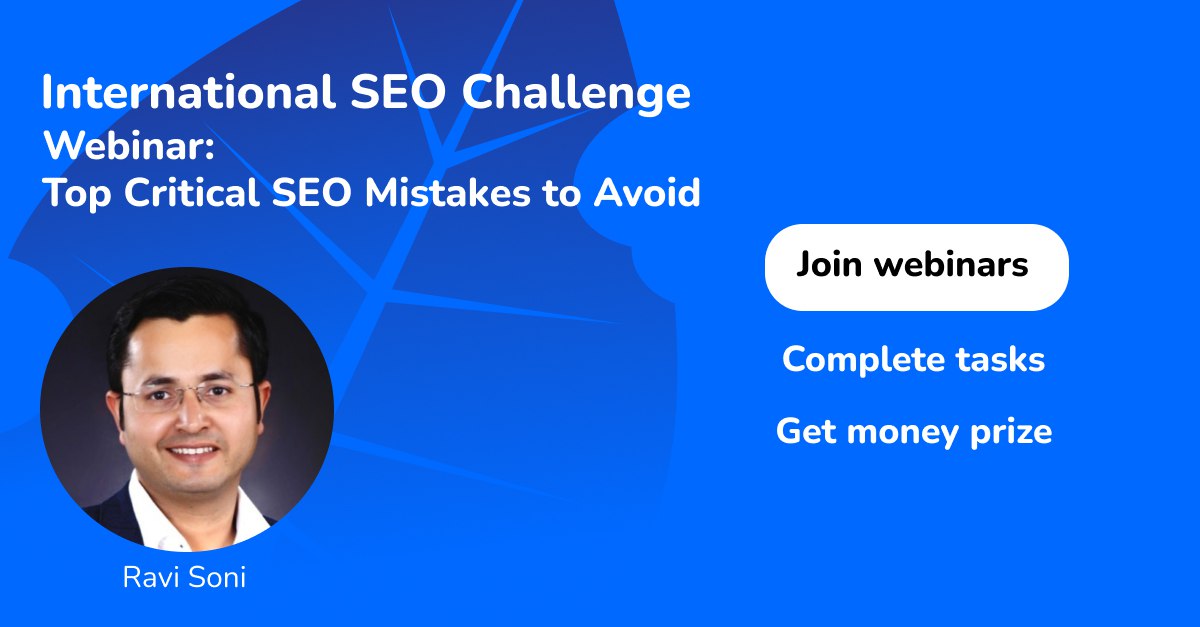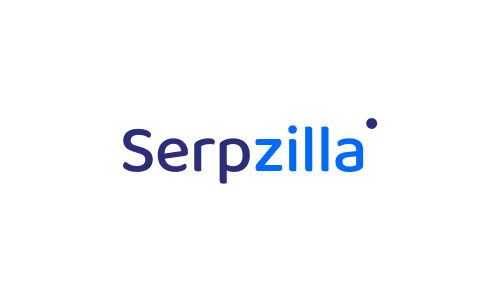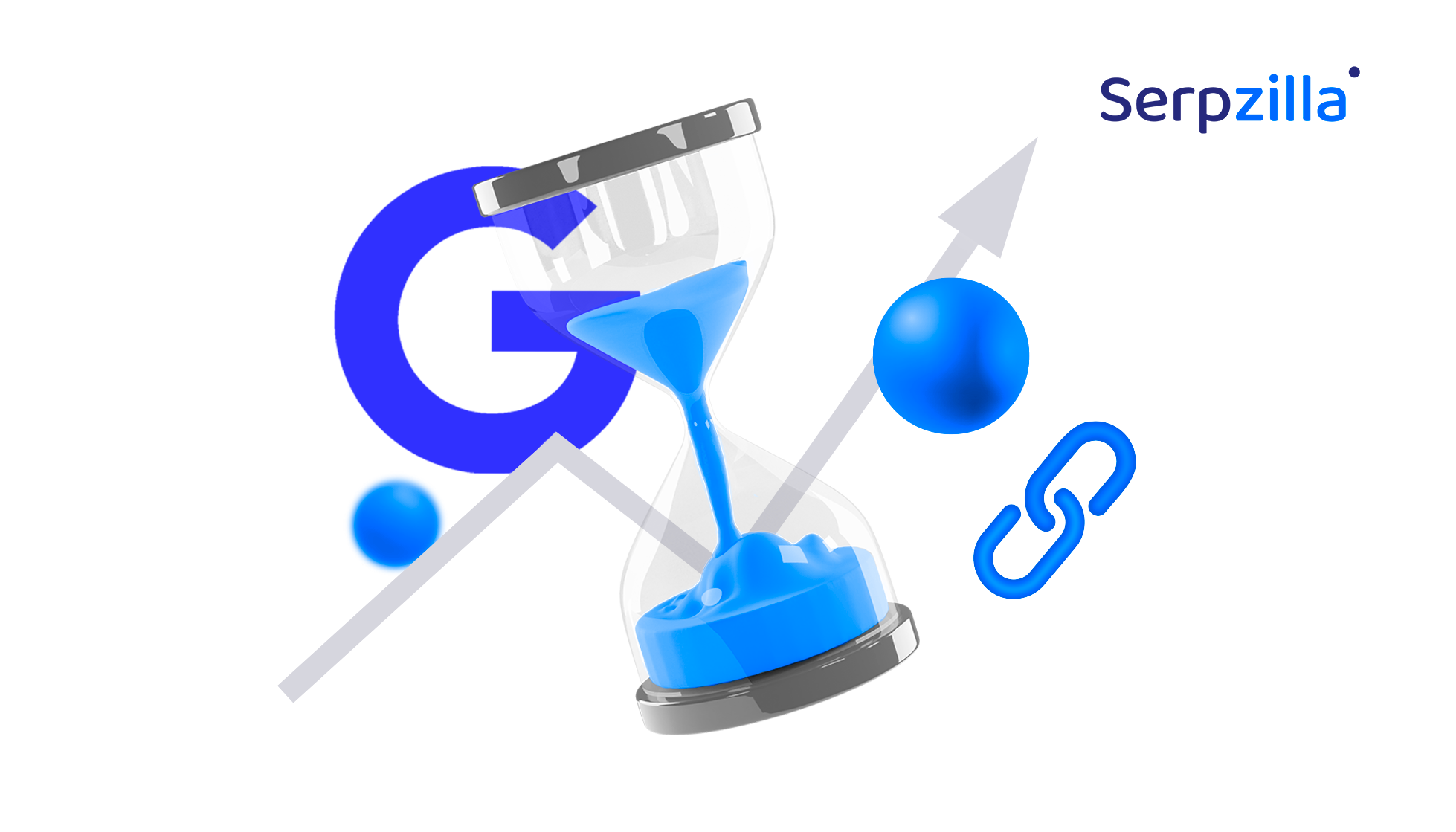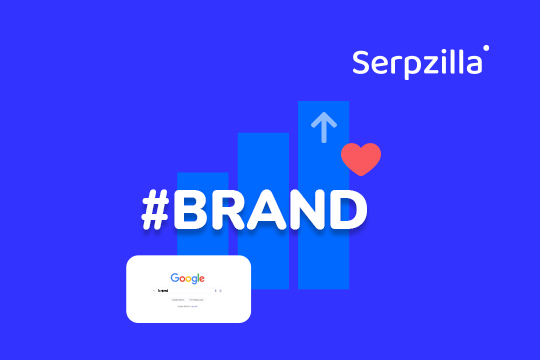Link building is a goldmine for effective SEO, but handling it in-house can drain your resources and budget. You might be thinking: “Why don’t I outsource link building then?” It seems like a smart shortcut — if you approach it strategically. Otherwise, you risk paying for ineffective links and damaging your rankings.
This step-by-step guide shows you exactly how to choose reliable backlink providers, set realistic goals, and monitor results without guesswork. You’ll find practical, actionable tips to help you outsource safely and effectively.
How Outsourcing Link Building Works
When you outsource link building, you’re turning to external expertise to manage the process of securing backlinks for your site. Typically, you can choose between three types of link-building providers: SEO agencies, freelance link builders, and specialized platforms like Serpzilla. Let’s take a look at the key differences between them:
| SEO agencies | Individual freelancers | Specialized SEO platforms | |
| Cost | High | Moderate | Affordable |
| Service Coverage | Comprehensive | Flexible | Customized and direct |
| Speed | Slow | Moderate | Fast |
| Ease of Use | High (managed) | Medium (some effort) | High (user-friendly) |
SEO agencies
SEO agencies are full-service companies that manage the entire link-building process for you. They basically take the task off your plate. This hands-off approach makes agencies a good choice for large businesses with a high budget but limited in-house SEO expertise.
A SEO agency usually starts with a full audit of your website and backlink profile, then creates a custom strategy based on your goal. From there, agency experts handle every part of the link-building process: outreach, content production, negotiation, placement, and reporting.
Most agencies work with a network of publishers and use white-hat methods to acquire links, such as:
- Guest posting
- Digital PR
- Niche outreach
The level of service is comprehensive, but it often means long lead times: getting a single link can take weeks. Besides, pricing is typically based on packages and gives little to no transparency into how much you’re paying per link or where it’s coming from.
Bottom line: if you want quality links with minimal involvement and have the budget to pay for the convenience, an SEO agency is a solid choice. But if you’re after fast results, tighter control, or clearer reporting, you may run into friction.
👩💼 Freelancers
Freelancers are individual experts who usually offer link-building services on a project-by-project basis. Freelancers cover a wide spectrum, from seasoned specialists who run their own outreach systems to beginners experimenting with guest posting. You’ll find them on platforms like Upwork, Fiverr, or through SEO communities. They typically charge per link, per hour, or per project.
This option gives you more control over the process: you can hand-pick the freelancer, set expectations, and monitor performance closely. But it also means taking on more responsibility, including:
- Briefing
- Reviewing drafts
- Managing deadlines
- (Sometimes) dealing with inconsistent quality
Since freelancers usually work solo, their output is limited, and they might not offer advanced analytics or reporting unless you specifically ask for it.
Bottom line: freelancers can be a great middle ground for small businesses or SEOs who know what they want and are ready to stay involved. Just be prepared to spend time finding and managing the right person — it’s not always easy.
💻 Specialized platforms
Specialized platforms are online tools that give you direct access to a wide range of backlink opportunities. For example, Serpzilla provides a large database of available link placements across various niches. The platform allows you to filter, select, and place links with just a few clicks. On top of that, you get transparent and flexible pricing, clear SEO metrics (DR, traffic, and anchor options), and performance tracking capabilities.
This model eliminates the need for outreach, negotiation, and waiting. Once you find a link you like, you can buy and publish it quickly. Speed and cost-efficiency are major benefits here: you’re not paying for middlemen or bloated retainers. Instead, you get direct access to link inventory and retain full control over your strategy. However, the wide range of options available can feel overwhelming at first, especially if you’re new to link building. That’s why it helps to define clear selection criteria — you’ll learn more about them in the following section of this guide.
Bottom line: specialized link-building platforms offer unmatched speed, scalability, and control, especially for businesses with defined growth goals.
How to Outsource Link Building in 6 Simple Steps
So, backlink outsourcing isn’t simply about finding someone to “get you links.” To see real results and avoid wasting time and budget, you need a smart, transparent approach. Here’s how to do it right:
Step 1. Set realistic goals tied to business outcomes
The rule of thumb here is to steer clear of vague targets. Instead of setting goals like “get 100 links,” figure out exactly what those links should achieve. Are you aiming to increase rankings for a specific landing page? Do you want to improve domain authority or build local relevance? Be as specific as you can. This way, you’ll be able to measure success and communicate expectations to any provider you end up choosing.
| Example of a specific goal: “Secure 20 contextual backlinks to our product page from websites with DR 40+ to increase rankings for the keyword ‘best HR software’ and boost traffic by 25% over three months.” |
Step 2. Define your quality benchmarks
You probably already know this, but it doesn’t hurt to remind yourself that not all links are created equal. That’s why it’s important to set clear criteria before you begin: think about domain authority ranges, traffic minimums, link types (contextual vs. sidebar), and anchor diversity.
The best way to define your criteria is via competitor analysis, including the types of links competitors use and the parameters of those links. After all, one of your goals is to outperform your competitors in search results. Knowing what’s already working for them gives you a benchmark to beat.
This is especially convenient to do if you’re using a specialized link-building platform. You can quickly set relevant filters or sometimes create a custom filter to surface only the types of links that meet your bar. If you’re hiring a freelancer or agency, you’ll need to share examples of acceptable and unacceptable links.
| Example of clear link criteria: “Accept only links from domains with DR 40+, 1K+ monthly organic traffic, and contextual placement within editorial content. Avoid directories, blogrolls, or pages with obvious footprints.” |
Step 3. Choose your outsourcing model
The best way to choose between an agency, a freelancer, or a specialized platform is to base the decision on your in-house strengths. You can start by assessing what capabilities you already have.
- If you have someone who can outline a strategy but lack outreach resources, a platform is often the smartest option. It lets your team stay in control while handling the execution quickly and affordably.
- If you need a fully managed solution and have the budget to spend, an agency can take the process off your plate.
- Freelancers can work well for hands-on teams who have time to guide and review every step. But as already mentioned, this approach can be slower and more dependent on individual reliability.
| Example of a strength-based use case: A B2B SaaS company with a content strategist in-house but no team for outreach or negotiation might use a platform like Serpzilla to filter opportunities by DR, traffic, and page context, allowing them to maintain quality and scale fast without hiring additional staff. |
Pro tip: Test before committing long-term if you can. For example, you can run a small pilot: 5–10 links, one target page, one provider or platform. Track link delivery, communication, transparency, and how closely they follow your instructions.
Requesting a demo is also a smart move. With Serpzilla, you can hop on a live demo where you’ll see how the platform works and get tailored recommendations for selecting the most effective backlink placements for your needs. If you’re not a fan of live meetings, you can watch a full pre-recorded demo to make your assessment. Think of this as QA for your strategy.
Step 4. Align expectations and keep clear communication
Clear communication is simply a must for any type of successful outsourcing relationship. If you’re working with freelancers or agencies, start by creating a detailed brief. This should include your link goals, acceptable and unacceptable domains, page types to avoid, timeline expectations, and other criteria you find important. Include examples of both ideal and unacceptable links.
| Example of a brief: “We’re building links to our blog post on employee onboarding software. Please focus on dofollow, contextual links placed within relevant HR or business articles. We’re targeting mid-tier sites (DR 35–60) with at least 2,000 monthly organic visits. Avoid links from sites in unrelated niches like gambling or crypto. Use natural anchor text based on the context of the article. Avoid over-optimization or unnatural links. We’re aiming for 8–10 live links within the next three weeks. Target page: /link/.” |
Be sure to discuss your budget upfront, whether it’s per link, per month, or per campaign. If you expect reporting or performance metrics, state that early as well. Agree on what success looks like (e.g., DR thresholds, number of links, live date windows) to avoid mismatched expectations.
With platforms, your clarity comes from systematization. Keep a log of which filters, anchor types, DR ranges, and site categories perform best.
Pro tip: Use tags or naming conventions to group link campaigns by purpose. This makes it easier to replicate what works and train others if your team grows in the future. Keeping this type of documentation might sound tedious, but it helps avoid ambiguity and saves you from repeating instructions. It also becomes your internal playbook for scaling and helps you stay consistent.
Step 5. Monitor results (beyond link quantity)
It’s easy to get distracted by volume, but real value lies in specific business outcomes. So it’s a good idea to track metrics and trends like:
- Keyword movements
- Organic traffic to target pages
- Domain diversity, etc.
Platforms often integrate analytics or exportable reports. Use these to assess the link-building campaign’s success and optimize accordingly.
| Example of successful business results: One of Serpzilla’s clients that provides a remote development team recruitment service in India experienced a dive in website traffic. By outsourcing linkbuilding to Serpzilla, the service achieved an increase in keyword visibility by 272% (from 18 to 49) and a jump in daily traffic by 239% (from 33 to 112 daily visitors). |
Step 6. Scale up the process
Once you’ve dialed in your strategy, systems, and vendor relationships, it’s time to scale. Use what you’ve learned from earlier campaigns to replicate success across more pages, products, or regions.
- With platforms, this is as simple as duplicating your best-performing filters and automating link placement across multiple targets.
- For freelancers and agencies, consider creating a standardized playbook or onboarding doc to speed up execution and minimize tedious back-and-forth.
Don’t scale just by increasing link volume. Instead, refine what’s already worked for you. Expand anchor diversity, test new content formats, and revisit your list of linkable assets. As you grow, keep an eye on diminishing returns and shift focus to higher-value placements.
Pros and Cons of Outsourcing Link Building
It might sound like backlink outsourcing is an all-around great choice. However, it’s not that simple. This approach, like any other, has its drawbacks. Let’s take a look at both sides of the coin:
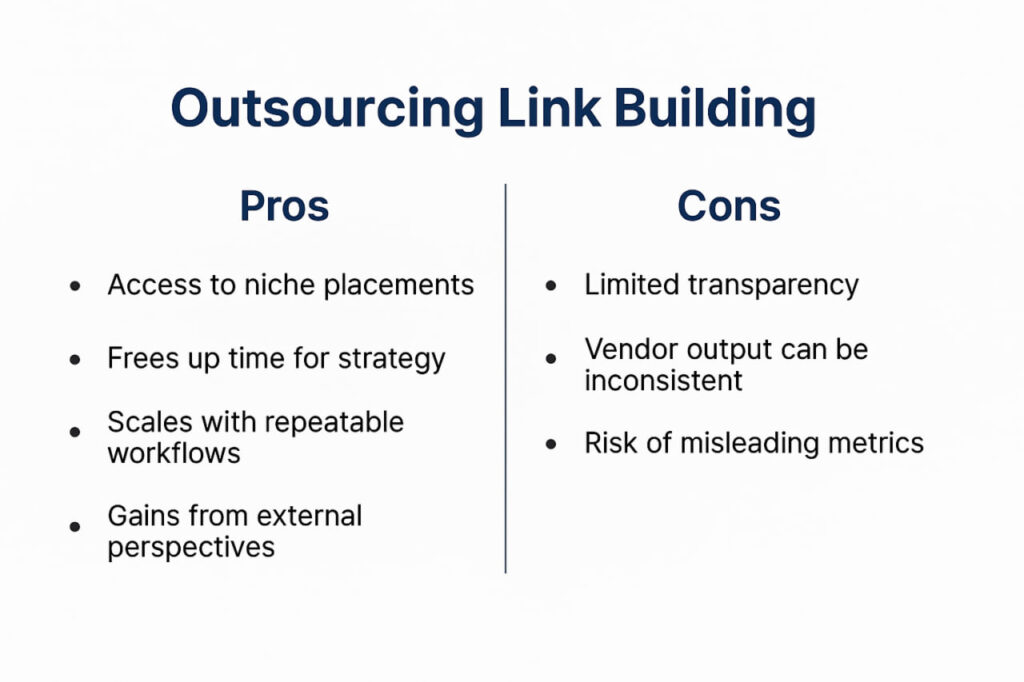
Pros
- Access to niche placements. Outsourcing opens doors to highly specific link opportunities that might be invisible to you or your in-house team. Think local blogs in niche industries, trade publications, or international markets. These are often the types of placements that offer higher relevance and authority but are harder to earn without existing relationships or local knowledge on your part. With outsourcing, the problem is solved right away.
- More time for other SEO tasks. By outsourcing the repetitive and time-intensive parts of link building, you can focus on higher-impact efforts. It may be improving conversion pages, refreshing content, or refining technical SEO. This reallocation is a huge advantage for small teams that wear many hats.
- Repeatable workflows for predictable growth. When you find a strategy that works, you can standardize it into a repeatable link-building workflow. That means you can scale more predictably without compromising link quality.
- “Cross-pollination” of ideas and perspectives. Working with different vendors and platforms exposes you to a wide range of approaches, from creative outreach methods to insights into what types of content attract links fastest in your niche. It’s nice to learn from the best, right?
Cons
- Limited transparency. We’ve already mentioned this: you rarely see the actual pitch emails, the publisher conversations, or the trade-offs made during outreach, especially with agencies and freelancers. This can make it harder to fully assess quality, tone, or how scalable the process really is.
- Inconsistent output across vendors. Even two equally priced services may deliver very different results. One might secure links on high-traffic, well-edited blogs, while another places content on low-engagement sites with minimal editorial oversight. Without active QA, you won’t know until links go live.
- Surface-level metrics can be misleading. A DR 50 link might look great on a report, but then you find out that it comes from a site with zero topical relevance or real visitors. Without vetting for contextual fit, you could rack up impressive-looking stats that don’t actually make a difference.
As you can see, linkbuilding outsourcing isn’t a silver bullet. But don’t worry, it’s not a gamble either. Treat it like a system you build, monitor, and optimize over time, and you’ll be fine.
Common Outsourcing Mistakes and How to Avoid Them
Alright, you’ve decided to outsource SEO link building. That’s a smart move, but smart moves can go sideways when you’re not aware of the hidden traps along the way. Even seasoned SEO experts can slip here and there. Pay attention to these three mistakes and discover how to avoid them early:

❌ Not syncing with your content team
If your content team (internal or external) isn’t in the loop, you risk pointing links to outdated or under-optimized pages. This disconnect leads to missed opportunities and a lower SEO value of your outsourcing efforts. For example, you may accidentally promote a page that’s about to be redirected or even removed. In other words, this creates a scenario where strong backlinks get wasted on thin or irrelevant content.
✅ How to avoid: Before any outsourcing campaign, confirm:
- Which URLs the content team is updating
- Which are due for rewrites
- Which need support
Prioritize link building only for conversion-optimized pages.
❌ Ignoring local opportunities
When you outsource to global vendors or platforms, many of these companies default to English-language, general-topic services. Essentially, they often overlook sites or publishers that specialize in local SEO and markets. This limits your reach in key regions, especially if you’re targeting multilingual audiences or operating in diverse locales.
✅ How to avoid: Use platforms or vendors that support geo-targeted filtering. You can start with the basics: prioritize .de domains for German pages or look for sites that rank in your local SERPs. Relevance beats global reach when it comes to regional rankings.
❌ Forgetting to track link decay
Just because a link was placed doesn’t mean it will stay live. Links get removed, deindexed, or nofollowed over time. When you’re outsourcing, you may not even realize it’s happening unless you’ve set up the right tracking mechanisms. That’s why your link profile can quietly erode while you assume progress is being made.
✅ How to avoid: Run regular link audits. For example, you can use specialized platform alerts to flag removed links on a quarterly basis. With agencies and freelancers, you can negotiate guarantees or replacements upfront.
Classic Outsourcing vs. Serpzilla: A Transparent Alternative
By now, it’s clear that outsourcing link building can drive serious results. Yet, it also comes with its share of friction, especially when you rely on traditional vendors. From inconsistent output to limited control, many of the common pitfalls stem from how the process is managed behind the scenes. You risk paying not just for links, but for communication overhead and invisible margins.
Serpzilla is designed to flip that model. Instead of outsourcing everything (including control over your link-building success), you get full access to a massive catalog of real, available link placements.
Here’s how Serpzilla solves the biggest pain points of classic outsourcing:
- Full pricing transparency. You know exactly what each link costs before you buy. There are no vague packages, markups, or hidden fees.
- Total control. You handpick each link based on DR, traffic, content type, and relevance. Nothing goes live without your approval.
- Built-in automation. You can finally skip the endless back-and-forth. The outreach, negotiation, and placement are already handled.
The bottom line is: you don’t have to sacrifice quality for speed or price for scale. Serpzilla is a practical, flexible solution that gives SEO managers and teams the control they need without burning resources on coordination.
Try it for yourself and get immediate access to thousands of vetted link opportunities. Experience faster, easier, and smarter backlink outsourcing.



